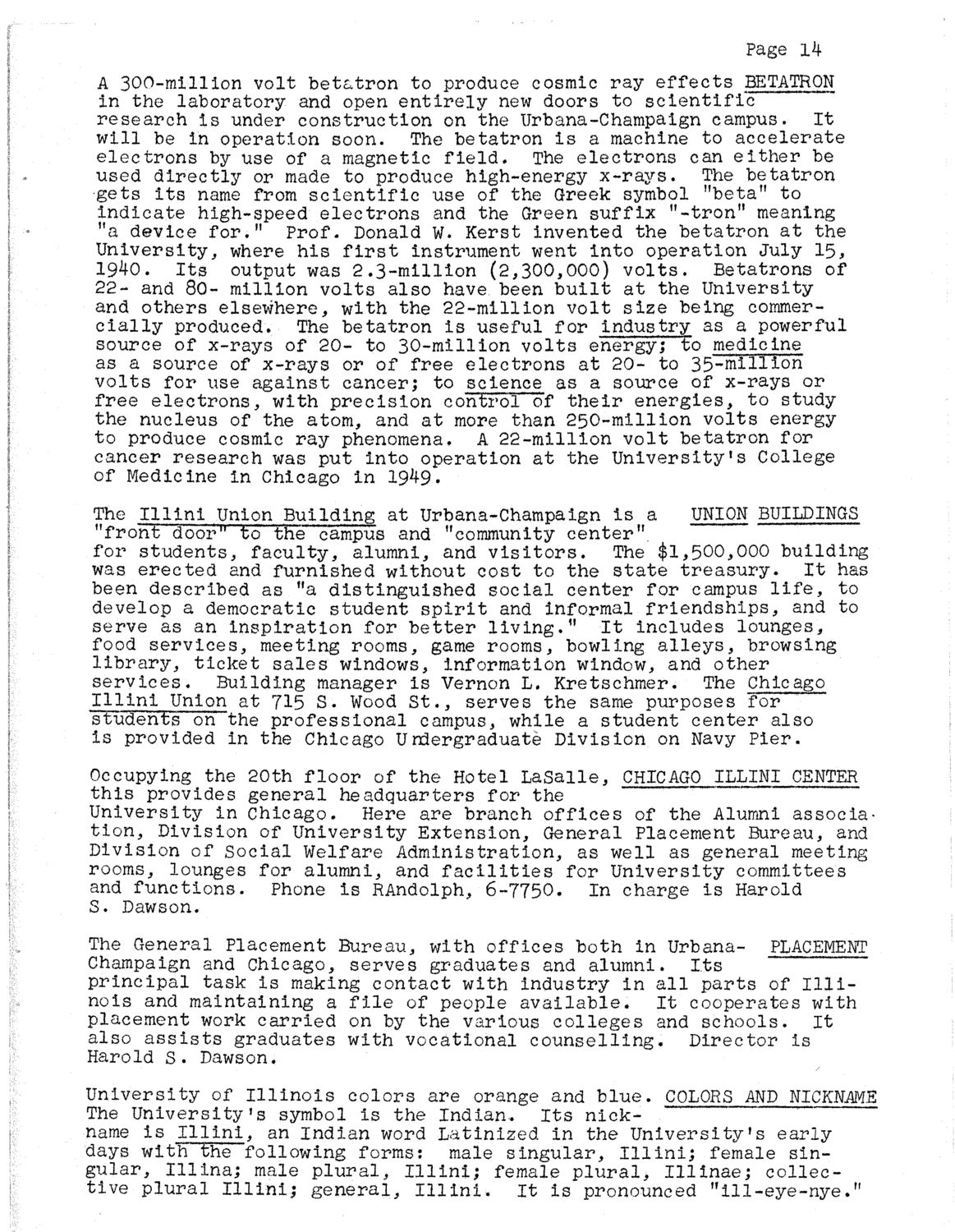| |
| |
Caption: Reference Folder - 1949
This is a reduced-resolution page image for fast online browsing.

EXTRACTED TEXT FROM PAGE:
Page 14 A 300-million volt betatron to produce cosmic ray effects BETATRON in the laboratory and open entirely new doors to scientific research is under construction on the Urbana-Champaign campus. It will be in operation soon. The betatron is a machine to accelerate electrons by use of a magnetic field. The electrons can either be used directly or made to produce high-energy x-rays. The betatron gets its name from scientific use of the Greek symbol "beta" to indicate high-speed electrons and the Green suffix "-tron" meaning "a device for." Prof. Donald W. Kerst invented the betatron at the University, where his first instrument went into operation July 15, 1940. Its output was 2.3-mlllion (2,300,000) volts. Betatrons of 22- and 80- million volts also have been built at the University and others elsewhere, with the 22-mlllion volt size being commercially produced. The betatron is useful for Industry as a powerful source of x-rays of 20- to 30-million volts energy; to medicine as a source of x-rays or of free electrons at 20- to 35-million volts for use against cancer; to science as a source of x-rays or free electrons, with precision control of their energies, to study the nucleus of the atom, and at more than 250-million volts energy to produce cosmic ray phenomena. A 22-million volt betatron for cancer research was put into operation at the University's College of Medicine in Chicago in 1949. The Illlni Union Building at Urbana-Champaign is a UNION BUILDINGS "front door" to the campus and "community center" for students, faculty, alumni, and visitors. The $1,500,000 building was erected and furnished without cost to the state treasury. It has been described as "a distinguished social center for campus life, to develop a democratic student spirit and Informal friendships, and to serve as an inspiration for better living." It includes lounges, food services, meeting rooms, game rooms, bowling alleys, browsing library, ticket sales windows, information window, and other services. Building manager is Vernon L. Kretschmer. The Chicago Illlni Union at 715 S. Wood St., serves the same purposes for students on the professional campus, while a student center also is provided in the Chicago Undergraduate Division on Navy Pier. Occupying the 20th floor of the Hotel LaSalle, CHICAGO ILLINI CENTER this provides general headquarters for the University in Chicago. Here are branch offices of the Alumni association, Division of University Extension, General Placement Bureau, and Division of Social Welfare Administration, as well as general meeting rooms, lounges for alumni, and facilities for University committees and functions. Phone is RAndolph, 6-7750. In charge is Harold S. Dawson. The General Placement Bureau, with offices both in Urbana- PLACEMENT Champaign and Chicago, serves graduates and alumni. Its principal task is making contact with industry in all parts of Illinois and maintaining a file of people available. It cooperates with placement work carried on by the various colleges and schools. It also assists graduates with vocational counselling. Director is Harold S. Dawson. University of Illinois colors are orange and blue. COLORS AND NICKNAME The University's symbol is the Indian. Its nickname is illlni, an Indian word Latinized in the University's early days with the following forms; male singular, Illlni; female singular, Illina; male plural, Illlni; female plural, Illinae; collective plural Illlni; general, Illlni. It is pronounced "ill-eye-nye."
| |